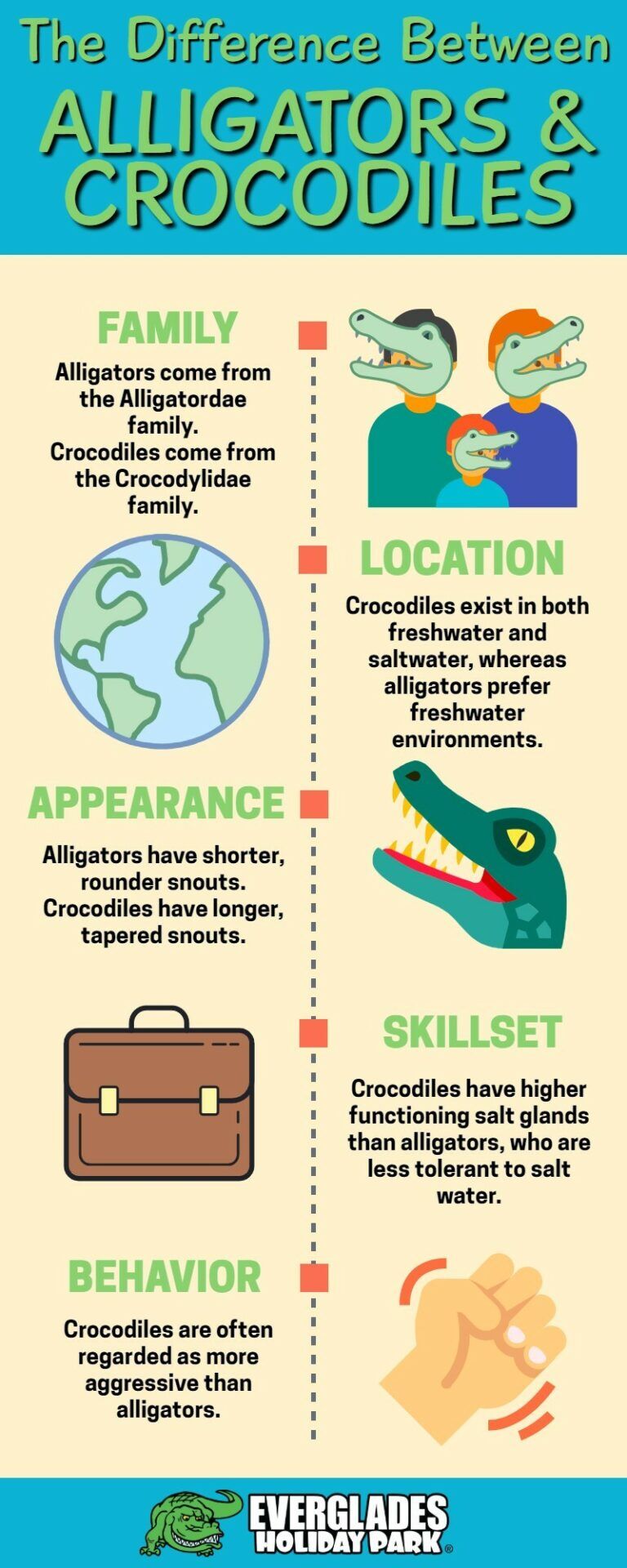The Difference Between the Alligators & Crocodiles of the Everglades
Learn about the difference between alligators and crocodiles. Then see alligators up close on an Everglades airboat tour.
What’s the difference between an alligator vs crocodile? If you’ve ever visited the Sunshine State, you can’t miss them. No, we’re not talking about people in flip flops; we’re talking about alligators! They’re big, they’re exciting to watch, and they’re everywhere you look in the Everglades. In fact, as Floridians, we’re used to sharing our gorgeous state with them, and we respect the contribution they’ve made to our home. But what about crocodiles? There are distinct differences between alligators and crocodiles. If you’ve found yourself on Everglades airboat tours and in a situation where you can’t tell if the animal in front of you is an alligator or a crocodile, here are a few tips to help you differentiate the two.
To most people, alligators and crocodiles look similar. While they do share many of the same features, they couldn’t be any more different to a trained professional. Typically, crocodiles are more aggressive than alligators, which makes crocodiles more dangerous than alligators. Alligators are opportunistic feeders, meaning that they’re not likely to chase you down unless they’re provoked. However, that certainly doesn’t mean that you should swim with them. Caution and common sense should be exercised at all times near and around both alligators and crocodiles on an Everglades excursion.
When it comes to differentiating between alligators and crocodiles, observing their snout shape and jawline is often one of the quickest and most reliable methods, especially in a natural setting like an airboat tour in Miami or other areas where these reptiles are found.
Alligators typically have a broader, rounded snout with a U-shaped appearance. This snout shape is well-suited for exerting strong bite force and is particularly effective for crushing and breaking open tough prey items like turtles.
On the other hand, crocodiles tend to have a narrower, more pointed snout with a V-shaped snout appearance. This snout shape is adapted for capturing a variety of prey, including fish and other smaller animals. The pointed snout allows for more precision when hunting, and it’s also useful for catching fast-moving prey in the water.
These differences in snout shape reflect the different ecological roles and prey preferences of alligators and crocodiles. However, it’s important to note that while snout shape is a useful characteristic for identification, there are other anatomical and behavioral differences between these two groups as well.
alligators have a wider upper jaw, which results in their teeth being mostly hidden when their mouths are closed. This gives them a more subtle and less toothy appearance. On the other hand, crocodiles have upper and lower jaws that are more or less the same size, leading to their teeth being visible even when their mouths are closed. This can indeed create the impression of a “toothy grin.”
These distinct jawline features are often observable even from a distance and can be helpful in differentiating between alligators and crocodiles, especially in regions where both types of reptiles are found. It’s important to note that these visual characteristics, along with other features like snout shape and habitat preferences, can collectively aid in distinguishing between the two groups.
It’s important to note that size and weight can be influenced by various factors including genetics, habitat, available food sources, and age. The figures you mentioned are accurate as general ranges, but there can be some variability within each species. Additionally, specific measurements might change due to new discoveries or updated data.
If you encounter these reptiles in the wild, it’s important to maintain a safe distance and respect their natural behaviors and habitats.
It’s important to note that while these general characteristics apply to both alligators and crocodiles as a group, there can be variations among different species and individual animals.
The Crocodylidae family includes 15 species of “true” crocodiles, and the Alligatoridae family contains eight species of alligators and caimans.
These beautiful animals can be found all over the world – wherever slow-flowing rivers and grasslands dominate that you could see on an Everglades boat.
Understanding the habitat preferences and geographical distributions of alligators and crocodiles is not only fascinating but also important for conservation efforts and ensuring the well-being of these remarkable reptiles.
Are you ready to come face-to-face with a living dinosaur? You can at Everglades Holiday Park! Our Gator Park is a premier destination for families, outdoor enthusiasts, and reptile aficionados alike. There’s no better place to experience exciting Everglades airboat tours, live alligator presentations, and Everglades animal encounters with the chance to pose with a baby alligator for a picture. Our park is South Florida’s best family fun locale for adventure.
As home to the Gator Boys Alligator Rescue, Everglades Holiday Park welcomes families, outdoor enthusiasts, and anyone interested in Everglades sightseeing and journeying through the ‘Glades in search of alligators, wading birds, fish, snakes, and more!
An Everglades tour is the perfect family activity and a great place to see alligators from a close but safe distance. Book your tickets today for an adventure at Everglades Holiday Park that you definitely won’t forget!

Learn about the difference between alligators and crocodiles. Then see alligators up close on an Everglades airboat tour.
Where you go will affect your success and what kind of fish your trip yields. Here’s a list of some of the best places to fish:
There are things that you can see in Everglades that you can’t see anywhere else.